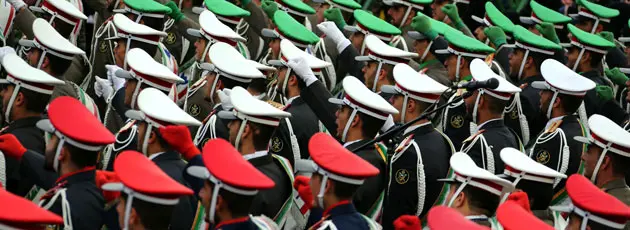Washington is becoming increasingly confrontational when it comes to Iran and the future of the nuclear deal, while European policymakers have been at pains to emphasise its importance. As Paulina Izewicz explains, Europe appears increasingly ready to chart its own course.
On 17 July, the Trump administration again certified Iran’s compliance with the Joint Comprehensive Plan of Action (JCPOA). However, it did so amid serious internal disagreements, and nearly missing the legal deadline. According to a New York Times account of those deliberations, all of President Trump’s key advisers supported making the certification, while he himself reportedly ‘spent 55 minutes of the meeting telling them he did not want to’. Ultimately, the certification was issued, with a curious contention that Iran, while technically in compliance with the JCPOA, is ‘in default of its spirit’. If one were to read between the lines, Iran’s nuclear behaviour may not be the main determinant of its compliance when certification is next due in another 90 days.
In that, the United States and Europe do not see eye to eye. When a new report by the UN Secretary-General on Iran’s compliance with the new resolution regulating the Iran file, UNSCR 2231, was briefed to the Security Council last month, EU and UN representatives praised the benefits of the nuclear deal. The US ambassador to the UN Nikki Haley, in turn, concluded that the report was ‘filled with devastating evidence of the nature of the Iranian regime’ and lambasted Iran's ‘destructive and destabilizing role in the Middle East’.
Indeed, as the US approach becomes more and more confrontational, Europe appears increasingly ready to chart its own course on Iran. On several occasions in recent weeks, the EU’s foreign policy chief, Federica Mogherini, has underscored Europe’s continued commitment to the accord, once pointedly remarking that ‘the nuclear deal doesn't belong to one country’. With transatlantic relations rapidly cooling since Donald Trump took office, a European policy on Iran not aligned with that of the United States no longer seems inconceivable.
Europeans look to re-engage
From the European perspective, verifiable constraints on Iran’s nuclear programme addressed the most pressing issue, providing space and goodwill to, with time, begin dialogue in other areas. Indeed, in April 2016, Federica Mogherini and Iran’s Foreign Minister Mohammad Javad Zarif issued a joint communiqué outlining a broad agenda for cooperation spanning regional issues, migration, education and culture, among others. Significantly, Iran also expressed willingness to engage with the EU on human-rights issues, an area that typically had been off limits.
Economic considerations, of course, have also played a significant role. Unlike the United States, Europe maintained trade relations with Iran in the wake of the Islamic Revolution, curbed only when the nuclear crisis erupted. With the JCPOA in place, Europeans are eager to re-engage. A stream of deals in just the past two weeks attests to that: France’s Total, joined by China’s CNPC, signed a US$5 billion gas deal; Italian state railways entered into an agreement worth roughly €1.2bn; Germany’s Volkswagen announced its return to Iran, and Nokia signed a memorandum of understanding for the development of 5G technology in Iran.
Washington draws up charge sheet
Meanwhile, the Trump administration and the Republican-led Congress have been highly critical of Iran’s actions in non-nuclear areas. With its ballistic missile tests, regional behaviour, human-rights abuses and detention of US citizens, Iran has given critics plenty of ammunition. Whether any of this should or indeed could have been included in the nuclear agreement is a matter for separate debate. But it increasingly appears that the Trump administration intends to confront Iran in these other areas, and to hold the JCPOA hostage in the process.
The various timelines attached to the agreement give the Trump team multiple action-forcing deadlines: apart from the 90-day certification mentioned above, sanctions waivers are due every 120 and 180 days. In addition, a policy review is currently underway to determine whether the continued lifting of sanctions is ‘vital to the national security interests of the United States’. The original deadline for this review, mid-July, has now been extended to an undetermined point before the next Congressional certification is due in October.
European leverage
These shifting goalposts, coupled with the increasingly confrontational rhetoric, have clearly been a source of frustration in European capitals. In a largely unnoticed attempt at public outreach, last week UK Foreign Secretary Boris Johnson penned an op-ed in the Washington Post in defence of the JCPOA, reinforcing the quiet lobbying on Capitol Hill by British diplomats earlier in the month. It is unclear, however, whether public or private diplomacy of the subtle European variety will have much impact on Donald Trump. A more straightforward message might be in order: if the United States chooses to walk away from the nuclear deal, it will be doing so on its own.
In that, Europe has some leverage. Barring a tit-for-tat response from Tehran amounting to a serious breach of the JCPOA, the re-imposition of EU sanctions is a rather unlikely prospect. In this context, it is worth remembering the impact of EU restrictions on SWIFT and the Iranian oil sector in the past.
The EU is also not without recourse in the one area where US withdrawal from the accord would be most acutely felt as a practical matter: so-called secondary sanctions. Such sanctions extend US jurisdiction to non-US persons, forcing them to choose between doing business with Iran or with the United States. In 1996, faced with a similar dilemma, the EU introduced a blocking statute to counter the extraterritorial character of US sanctions against Cuba and Iran. This legislation, still technically on the books, prohibits EU persons and entities from complying with US secondary sanctions, supplemented by a ‘claw-back clause’, allowing for the recovery of any losses suffered as a result.
To be sure, employing a tool of this calibre would not be without consequences and, at least until recently, was regarded in Brussels as a sort of ‘plan c’. Given the deteriorating relations, however, and Europe’s growing readiness to confront the United States in what would amount to a trade war, its position in the hierarchy may well have shifted. If so, communicating a willingness to exercise the legislation would not go amiss.
This article is adapted from IISS, and is not what APD stands for.
 简体中文
简体中文







